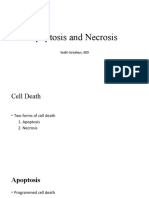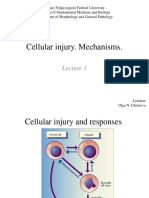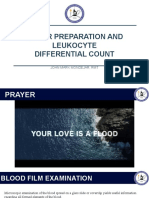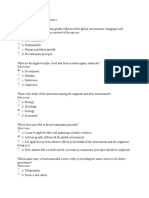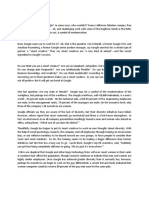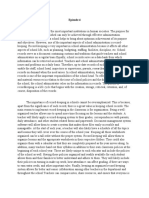0 ratings0% found this document useful (0 votes)
42 viewsCellular Responses To Stress and Toxic Insults
Cellular Responses To Stress and Toxic Insults
Uploaded by
AnastasiaCellular responses to stress and toxic insults can result in reversible or irreversible cell injury and cell death. Reversible cell injury is characterized by reduced ATP and cellular swelling due to ion concentration changes. Continuing damage leads to irreversible injury and cell death through either necrosis or apoptosis. Necrosis is unregulated cell death from membrane damage, while apoptosis is regulated cell suicide driven by genetic pathways. Causes of cell injury include oxygen deprivation, physical and chemical agents, infectious agents, immunologic reactions, genetic factors, and nutritional imbalances. Mechanisms of injury involve ATP depletion, mitochondrial damage, calcium dysregulation, oxidative stress, and membrane permeability defects. Morphologic changes in reversible injury include swelling and fatty change. Nec
Copyright:
© All Rights Reserved
Available Formats
Download as PDF, TXT or read online from Scribd
Cellular Responses To Stress and Toxic Insults
Cellular Responses To Stress and Toxic Insults
Uploaded by
Anastasia0 ratings0% found this document useful (0 votes)
42 views53 pagesCellular responses to stress and toxic insults can result in reversible or irreversible cell injury and cell death. Reversible cell injury is characterized by reduced ATP and cellular swelling due to ion concentration changes. Continuing damage leads to irreversible injury and cell death through either necrosis or apoptosis. Necrosis is unregulated cell death from membrane damage, while apoptosis is regulated cell suicide driven by genetic pathways. Causes of cell injury include oxygen deprivation, physical and chemical agents, infectious agents, immunologic reactions, genetic factors, and nutritional imbalances. Mechanisms of injury involve ATP depletion, mitochondrial damage, calcium dysregulation, oxidative stress, and membrane permeability defects. Morphologic changes in reversible injury include swelling and fatty change. Nec
Original Description:
cell injury
Original Title
cell Injury
Copyright
© © All Rights Reserved
Available Formats
PDF, TXT or read online from Scribd
Share this document
Did you find this document useful?
Is this content inappropriate?
Cellular responses to stress and toxic insults can result in reversible or irreversible cell injury and cell death. Reversible cell injury is characterized by reduced ATP and cellular swelling due to ion concentration changes. Continuing damage leads to irreversible injury and cell death through either necrosis or apoptosis. Necrosis is unregulated cell death from membrane damage, while apoptosis is regulated cell suicide driven by genetic pathways. Causes of cell injury include oxygen deprivation, physical and chemical agents, infectious agents, immunologic reactions, genetic factors, and nutritional imbalances. Mechanisms of injury involve ATP depletion, mitochondrial damage, calcium dysregulation, oxidative stress, and membrane permeability defects. Morphologic changes in reversible injury include swelling and fatty change. Nec
Copyright:
© All Rights Reserved
Available Formats
Download as PDF, TXT or read online from Scribd
Download as pdf or txt
0 ratings0% found this document useful (0 votes)
42 views53 pagesCellular Responses To Stress and Toxic Insults
Cellular Responses To Stress and Toxic Insults
Uploaded by
AnastasiaCellular responses to stress and toxic insults can result in reversible or irreversible cell injury and cell death. Reversible cell injury is characterized by reduced ATP and cellular swelling due to ion concentration changes. Continuing damage leads to irreversible injury and cell death through either necrosis or apoptosis. Necrosis is unregulated cell death from membrane damage, while apoptosis is regulated cell suicide driven by genetic pathways. Causes of cell injury include oxygen deprivation, physical and chemical agents, infectious agents, immunologic reactions, genetic factors, and nutritional imbalances. Mechanisms of injury involve ATP depletion, mitochondrial damage, calcium dysregulation, oxidative stress, and membrane permeability defects. Morphologic changes in reversible injury include swelling and fatty change. Nec
Copyright:
© All Rights Reserved
Available Formats
Download as PDF, TXT or read online from Scribd
Download as pdf or txt
You are on page 1of 53
Cellular Responses to
Stress and Toxic Insults
Overview of Cell Injury and
Cell Death
Reversible Cell Injury
• Hallmarks:
– Reduced oxidative phosphorylation resulting in
depleted ATP
– Cellular swelling caused by changes in ion
concentrations and water influx
Cell Death
• With continuing damage, injury becomes
irreversible, leading to cell death.
• Principal types:
– Necrosis
– Apoptosis
Necrosis
• “Accidental” and unregulated type of cell
death
• Damage to cell membranes and loss of ion
homeostasis
• Cellular contents leak into the extracellular
space, eliciting inflammation
• Always a pathologic process
Apoptosis
• When the cell’s DNA or proteins are damaged
beyond repair, the cell kills itself
• Characterized by nuclear dissolution,
fragmentation of the cell without complete
loss of membrane integrity, and rapid removal
of cell debris
• No inflammatory reaction
Apoptosis
• Highly regulated process driven by a series of
genetic pathways
• “Programmed cell death”
• Serves many normal functions
• Not necessarily associated with cell injury
Causes of Cell Injury
Oxygen Deprivation
• Hypoxia
– Oxygen deficiency
– Causes cell injury by reducing aerobic oxidative
respiration
Oxygen Deprivation
• Hypoxia
– Due to:
• Reduce blood flow (ischemia)
• Inadequate oxygenation (cardiorespiratory failure)
• Decreased oxygen carrying capacity (anemia)
• Severe blood loss
Oxygen Deprivation
• Depending on severity, cells may:
– Adapt
– Undergo injury
– Die
Physical Agents
• Mechanical trauma
• Extremes of temperature
– Burn
– Deep cold
• Sudden changes in atmospheric pressure
• Radiation
• Electric shock
Chemical Agents, Drugs
• Too many to compile!
• Simple chemicals like glucose and salt
• Oxygen at high concentrations
• Trace amounts of poison like arsenic and
cyanide
Chemical Agents, Drugs
• Pollution, insecticides, herbicides
• Carbon monoxide, asbestos
• Alcoholic beverage
• Therapeutic drugs
Infectious Agents
• From viruses to tapeworms
• Rickettsiae, bacteria, fungi and other parasites
Immunologic Reactions
• Immune System: defense against infectious
pathogens but may also cause cell injury in
the process
• Autoimmune disease
Genetic Derangements
• Extra chromosome: Down Syndrome
• Base pair substitution: Sickle cell
• Deficiency of functional proteins: inborn
errors of metabolism
• Polymorphisms
Nutritional Imbalances
• Protein-calorie deficiencies
• Vitamin deficiencies
• Self-imposed (bulemia, anorexia nervosa)
• Nutritional excess
Mechanisms of Cell Injury
Depletion of ATP
• Fundamental cause of necrotic cell death
• Produced in two ways:
– Oxidative phosphorylation (major)
• Oxygen reduction in mitochondria
– Glycolytic pathway
• In the absence of oxygen using glucose
Mitochondrial Damage
• Supply ATP
• Critical in cell injury and cell death
• Can be damaged by:
– Increases in cytosolic Ca2+
– Reactive oxygen species (ROS)
– Oxygen deprivation
– Mutations in mitochondrial DNA
Influx of Calcium and
Loss of Calcium Homeostasis
• Cytosolic free calcium is normally maintained
at ~0.1 umol
– Extracellular at 1.3 mmol
• Most intracellular calcium sequestered in
mitochondria and ER
• Increased in calcium:
– Released from calcium stores
– Influx across plasma membrane
Oxidative Stress
• Accumulation of oxygen-derived free radicals
(reactive oxygen species)
– Have a single unpaired electron
– Highly reactive with adjacent molecules (organic
and inorganic chemicals)
• Proteins, lipids, carbohydrates, nucleic acids
– Convert molecules into reactive species
Defects in Membrane Permeability
• Early loss of selective membrane permeability,
leading ultimately to overt membrane damage
• Consistent feature of cell injury (except
apoptosis)
• Mitochondrial, plasma and lysosomal
membranes
Damage to DNA and Proteins
• Cells have mechanisms to repair DNA damage,
however, when damage is too severe to be
corrected, the cell initiates a
suicide program APOPTOSIS
Morphologic Alterations in
Cell Injury
Reversible Cell Injury
• Under the light microscope:
– Cellular swelling
• Occurs when cells are incapable of maintaining ionic
and fluid homeostasis
– Fatty change
• Lipid vacuoles appear in the cytoplasm
• Occurs in cells involved/dependent on fat metabolism
Cellular Swelling
• First manifestation of almost all forms of
injury to cells
• Difficult to appreciate in LM
more evident in gross of whole organ
– Pallor
– Increaser turgor
– Increase in weight
Cellular Swelling
• Microscopy:
– Small clear vacuoles in the cytoplasm
• Distended/pinched-off segments of ER
• Hydropic change or vacuolar degeneration
– Increased eosinophilic staining
Ultrastructural Changes of
Reversible Cell Injury
• Plasma membrane alterations (blebbing,
blunting, loss of microvilli)
• Mitochondrial changes (swelling, appearance
of small amorphous densities)
• Dilation of the ER, with detachment of
polysomes)
• Nuclear alterations (disaggregation of granular
and fibrillar elements)
Irreversible Injury
• Inability to reverse mitochondrial dysfunction
• Profound disturbances in membrane function
Necrosis
• The result of denaturation of intracellular
proteins and enzymatic digestion of the
lethally injured cell
• Necrotic cells are digested by their own
lysozymes plus the lysozymes of leukocytes
Necrosis
• On electron microscopy:
– Discontinuities in plasma and organelle
membranes
– Marked dilation of mitochondria
– Intracytoplasmic myelin figures
– Amorphous debris
– Aggregates of fluffy material (denatured protein)
Patterns of Tissue Necrosis
Coagulative Necrosis
• Architecture of dead tissues is preserved for
some days
• Firm texture
• Injury denatures structureal proteins and
enzymes NO proteolysis
– Eosinophilic, anucleate cells
• Removed by phagocytosis
• Localized area: INFARCT
• Seen in all organs except brain
Liquefactive Necrosis
• Characterized by digestion of dead cells
• Liquid viscous tissue mass
• Focal bacterial/fungal infections
• Creamy yellow “pus” due to dead leukocytes
• Seen in CNS infarcts
Gangrenous Necrosis
• Not a specific pattern of death, but used in
clinical practice
• Usually applied to a limb that has lost its
blood supply leading to coagulative
necrosis of multiple tissue planes
• Wet gangrene: with superimposed bacterial
infection (C. perfringens)
Caseous Necrosis
• Most often in tuberculous infection
• “Cheese-like”
• Friable white appearance
• Granuloma: area of amorphous granular
necrosis enclosed by a distinctive
inflammatory border
Fat Necrosis
• Does not denote a specific pattern of necrosis
• Refers to focal areas of fat destruction
• E.g. Acute pancreatitis
• Fat saponification: fatty acids combine with
calcium
• Microscopic: outlines of necrotic fat cells with
basophilic calcium deposits surrounded by
inflammation
Fibrinoid Necrosis
• Special form usually seen in immune reactions
in blood vessels
• Typically occurs when complexes of antigens
and antibodies (“immune complexes”) are
deposited in the arterial walls
• Together with leaked fibrin, appears bright
pink and amorphous “fibrin-like”
See you next week (Prepare for a quiz)
Topics:
APOPTOSIS
AUTOPHAGY
INTRACELLULAR ACCUMULATIONS
PATHOLOGIC CALCIFICATION
CELLULAR AGING
INFLAMMATION AND REPAIR
You might also like
- The Secret of Life Wellness by Inna SegalDocument12 pagesThe Secret of Life Wellness by Inna SegalBeyond Words Publishing41% (17)
- BIR Organizational StructureDocument1 pageBIR Organizational StructureKayeCie RL100% (1)
- The Nature of RealityDocument3 pagesThe Nature of RealityDebashis Patra100% (1)
- Cell InjuryDocument118 pagesCell InjuryShanzayNo ratings yet
- N 540 Health PolicyDocument7 pagesN 540 Health Policyapi-267840127No ratings yet
- Kematian Sel Dan ApoptosisDocument85 pagesKematian Sel Dan ApoptosismayaNo ratings yet
- Cell Adaptation and Injury: Fort SalvadorDocument30 pagesCell Adaptation and Injury: Fort SalvadorFort SalvadorNo ratings yet
- Cell Injury 2023Document135 pagesCell Injury 2023Dexcel concepcionNo ratings yet
- Cell Injury: DR Nimesh Paudel Resident General Surgery Chitwan Medical CollegeDocument24 pagesCell Injury: DR Nimesh Paudel Resident General Surgery Chitwan Medical CollegeBijay yadavNo ratings yet
- Cellular Injury and NecrosisDocument68 pagesCellular Injury and NecrosisAl-Rejab JabdhirahNo ratings yet
- Early Cell Injury and Homeostasis Leading To Point of No Return Causes of Cellular InjuryDocument17 pagesEarly Cell Injury and Homeostasis Leading To Point of No Return Causes of Cellular InjurysridharNo ratings yet
- Cellular Responses To Stress and Toxic Insults: Adaptation, Injury, and DeathDocument26 pagesCellular Responses To Stress and Toxic Insults: Adaptation, Injury, and DeathHusam ShawaqfehNo ratings yet
- Cell Injury PathologyDocument40 pagesCell Injury Pathologyجود عصامNo ratings yet
- Pathology01 CellDeath Inflammation RepairDocument140 pagesPathology01 CellDeath Inflammation RepairMiguel AranaNo ratings yet
- Cell InjuryDocument48 pagesCell InjurySALWA ASHFIYA -No ratings yet
- Necrosisandapoptosis 190815141429Document28 pagesNecrosisandapoptosis 190815141429Bhupesh KumarNo ratings yet
- Cell Injury GDDocument41 pagesCell Injury GDJessica de Figueiredo soaresNo ratings yet
- The Cell As A Basis of Disease I Pakkiri 2014Document58 pagesThe Cell As A Basis of Disease I Pakkiri 2014misheckmkayNo ratings yet
- Cell Pathology and Jemi Dynamics NotesDocument7 pagesCell Pathology and Jemi Dynamics NotesArundhathyNo ratings yet
- Cell Injury - 09.08.2023.ppt-1Document38 pagesCell Injury - 09.08.2023.ppt-1Abdur RaquibNo ratings yet
- Cell Injury: DR Gerald Saldanha Dept of PathologyDocument46 pagesCell Injury: DR Gerald Saldanha Dept of PathologyFirst LuckNo ratings yet
- Pathophysiology Final 1Document162 pagesPathophysiology Final 1Yeshaa Mirani100% (1)
- 3.cell Injury NecrosisDocument82 pages3.cell Injury NecrosisRyan ColeNo ratings yet
- (MDP) Dr. Syamsu Rijal - Jejas Kematian Sel Last PDFDocument64 pages(MDP) Dr. Syamsu Rijal - Jejas Kematian Sel Last PDFAqma SabrinaNo ratings yet
- Pathology Introduction Cell Injury & AdoptationDocument123 pagesPathology Introduction Cell Injury & Adoptationchicagoboy23No ratings yet
- Cell Adaptation, Injury and DeathDocument91 pagesCell Adaptation, Injury and DeathAmera ElsayedNo ratings yet
- 17-5 Cell Injury and DeathDocument30 pages17-5 Cell Injury and DeathSajjad AliNo ratings yet
- Cell Injury 4&5Document57 pagesCell Injury 4&5xvg7k74wpkNo ratings yet
- CELL INJURY K.U.Document37 pagesCELL INJURY K.U.Albina Zainab P.TNo ratings yet
- Conference 1Document71 pagesConference 1titusonNo ratings yet
- Lecture 2 Cell Injury and InflammationDocument69 pagesLecture 2 Cell Injury and InflammationtangroNo ratings yet
- Cell Damage 2Document59 pagesCell Damage 2Saja GhanayemNo ratings yet
- 2024 - Cell Injury Cell Death and AdaptationsDocument36 pages2024 - Cell Injury Cell Death and AdaptationsDavid NathanNo ratings yet
- Cell InjuryDocument39 pagesCell InjuryZainul Iman Abdul MalekNo ratings yet
- NecroseDocument12 pagesNecroseJULIONo ratings yet
- Apoptosis: Programmed Cell Death: Dr. Maha AkkawiDocument50 pagesApoptosis: Programmed Cell Death: Dr. Maha AkkawiSara IsmailNo ratings yet
- Cell and Tissue InjuryDocument60 pagesCell and Tissue InjurydesiNo ratings yet
- Cell Death 2019Document56 pagesCell Death 2019eduNo ratings yet
- Path NotesDocument111 pagesPath NotesNirav Patel100% (1)
- Lecture 3 - The Cell and Reaction To Injury - 2 Sep 2006Document19 pagesLecture 3 - The Cell and Reaction To Injury - 2 Sep 2006api-3703352No ratings yet
- Pathology Review Flash CardsDocument137 pagesPathology Review Flash CardsBabak Barghy100% (1)
- Cellular Responses To Stress and Toxic Insults Adaptation Injury and Death Lecture UM MClinDent 2023 AP DR Omar Emad Ibrahim IMS MSUDocument47 pagesCellular Responses To Stress and Toxic Insults Adaptation Injury and Death Lecture UM MClinDent 2023 AP DR Omar Emad Ibrahim IMS MSUFoo Mei FongNo ratings yet
- Necrosis: Anmc General Pathology Lecture Series Cell, Cell Injury, Cell Death, and AdaptationsDocument73 pagesNecrosis: Anmc General Pathology Lecture Series Cell, Cell Injury, Cell Death, and AdaptationsHussain Ali Abbas KhanNo ratings yet
- Cell Injury Dr. Sarah AlsawmhiDocument74 pagesCell Injury Dr. Sarah Alsawmhimarwan20maykryNo ratings yet
- Pathos (Suffering) Logos: Pathology Is The Study of The Causes and Effects ofDocument70 pagesPathos (Suffering) Logos: Pathology Is The Study of The Causes and Effects ofahmed mokhtar100% (1)
- Apoptosis and Necrosis: Yodit Getahun, MDDocument37 pagesApoptosis and Necrosis: Yodit Getahun, MDWolderufaelNo ratings yet
- Cell Injury and Death: By: Taleya HidayatullahDocument49 pagesCell Injury and Death: By: Taleya HidayatullahtaleyaNo ratings yet
- 1 Cell Injury 2020Document43 pages1 Cell Injury 2020zakaldragoNo ratings yet
- Cellular Injury Necrosis ApoptosisDocument43 pagesCellular Injury Necrosis ApoptosisOman SetiyantoNo ratings yet
- 1 Cell InjuryDocument69 pages1 Cell InjuryOsama OsamaNo ratings yet
- Bio Chemistry of Aging: Seminar TopicDocument33 pagesBio Chemistry of Aging: Seminar Topicnaeem ahmed100% (1)
- Cell Injury Nursing - 091351Document15 pagesCell Injury Nursing - 091351doyinsolaolusanyaNo ratings yet
- Mechanisms of Cell InjuryDocument36 pagesMechanisms of Cell InjuryOluwatimileyin OdedejiNo ratings yet
- Cell Aging & Cell DeathDocument94 pagesCell Aging & Cell Deathcholan1177% (13)
- Doc-20230914-Wa0005 230915 094034Document48 pagesDoc-20230914-Wa0005 230915 094034taigacarizmaNo ratings yet
- Mechanisms of Cell InjuryDocument21 pagesMechanisms of Cell Injuryبراءة أحمد السلاماتNo ratings yet
- 3. adaptation and type of cell deathDocument25 pages3. adaptation and type of cell deathdillasemera2014No ratings yet
- Cell Injury and Cell Death: Mahmud GhaznawieDocument48 pagesCell Injury and Cell Death: Mahmud GhaznawieLIEBERKHUNNo ratings yet
- Cell InjuryDocument92 pagesCell InjuryMariam AlavidzeNo ratings yet
- Types of Reversible and Irreversible Cell InjuryDocument33 pagesTypes of Reversible and Irreversible Cell InjuryMuneeb AltafNo ratings yet
- Cell Injury Advanced Presentation With ImagesDocument13 pagesCell Injury Advanced Presentation With Imagesaditya827714No ratings yet
- Cell Injury: DR Gerald Saldanha Dept of PathologyDocument46 pagesCell Injury: DR Gerald Saldanha Dept of PathologyomarNo ratings yet
- CA WBC Diff Count Group 5Document7 pagesCA WBC Diff Count Group 5AnastasiaNo ratings yet
- Stool Exam - Routine, Conc. Method - Students'Document27 pagesStool Exam - Routine, Conc. Method - Students'Anastasia100% (1)
- Dracunculus Medinensis and Filarial WormsDocument19 pagesDracunculus Medinensis and Filarial WormsAnastasiaNo ratings yet
- Coagulation Tests: Clotting Time, Bleeding Time, Prothrombin Time, Activated Partial Thromboplastin TimeDocument15 pagesCoagulation Tests: Clotting Time, Bleeding Time, Prothrombin Time, Activated Partial Thromboplastin TimeAnastasiaNo ratings yet
- Smear Preparation and Leukocyte Differential Count: John Mark Mondejar, RMTDocument35 pagesSmear Preparation and Leukocyte Differential Count: John Mark Mondejar, RMTAnastasiaNo ratings yet
- Complete Blood Count - Student'sDocument20 pagesComplete Blood Count - Student'sAnastasia100% (1)
- Laboratory Tests For EndocrinologyDocument6 pagesLaboratory Tests For EndocrinologyAnastasia100% (1)
- Electrophoresis 2Document27 pagesElectrophoresis 2AnastasiaNo ratings yet
- Chain of Infection: Clinical MicrosDocument2 pagesChain of Infection: Clinical MicrosAnastasiaNo ratings yet
- Post Test - Cardiac ProfileDocument10 pagesPost Test - Cardiac ProfileAnastasiaNo ratings yet
- Printed Journals Available in The LibraryDocument9 pagesPrinted Journals Available in The LibraryAnastasiaNo ratings yet
- Electrophoresis: Prepared By: Lovelyn Mae E. Cuison, RMT, MSMTDocument27 pagesElectrophoresis: Prepared By: Lovelyn Mae E. Cuison, RMT, MSMTAnastasiaNo ratings yet
- Blood Bank Laboratory Assignment 2 - Endterm Ahg TestDocument5 pagesBlood Bank Laboratory Assignment 2 - Endterm Ahg TestAnastasiaNo ratings yet
- APA Formatting and Style Guide - Reference and In-Text CitationDocument20 pagesAPA Formatting and Style Guide - Reference and In-Text CitationAnastasiaNo ratings yet
- Philippine Medical Technology Act of 1969Document13 pagesPhilippine Medical Technology Act of 1969AnastasiaNo ratings yet
- Ge6200 Long Quiz 001Document7 pagesGe6200 Long Quiz 001Maia A100% (1)
- The Enhanced Community Quarantine Amidst The Pandemic Stephanie FrondosoDocument1 pageThe Enhanced Community Quarantine Amidst The Pandemic Stephanie FrondosoStephanie FrondosoNo ratings yet
- PEL - Annual Report - 2018Document3 pagesPEL - Annual Report - 2018Bilal AhmadNo ratings yet
- Placement Test TEXTO AUDIOS A B CDocument12 pagesPlacement Test TEXTO AUDIOS A B Clady.molina2689No ratings yet
- Control Accounts TipsDocument3 pagesControl Accounts TipsDoreth Bridgeman100% (1)
- AU Postcodes Jun19 v1.4 All AreasDocument219 pagesAU Postcodes Jun19 v1.4 All AreasSwum HtetNo ratings yet
- Whitney Houston: Agnes Hamann: Reading Material WorksheetDocument2 pagesWhitney Houston: Agnes Hamann: Reading Material WorksheetAgnieszka HamannNo ratings yet
- 9 Paz Vs RepublicDocument3 pages9 Paz Vs RepublicElla B.No ratings yet
- Keep Being You IsyanaDocument9 pagesKeep Being You IsyanamilaNo ratings yet
- Jesus - The Personal LiberatorDocument7 pagesJesus - The Personal LiberatorJuan Carlos Azmitia CarranzaNo ratings yet
- Assignment No. 1Document4 pagesAssignment No. 1Waqas Tayyab100% (1)
- The Role of The Broadcast Media in The Management of Environmental Health Issues in Enugu State, NigeriaDocument38 pagesThe Role of The Broadcast Media in The Management of Environmental Health Issues in Enugu State, NigeriaPst W C PetersNo ratings yet
- Org Structure and Master Data AssignmentDocument3 pagesOrg Structure and Master Data Assignmentzs_sapNo ratings yet
- CD Lab Prgms FinalDocument43 pagesCD Lab Prgms FinalPrasanna LathaNo ratings yet
- 1.simple Stress and StrainDocument26 pages1.simple Stress and StrainthirumalaikumaranNo ratings yet
- Current ElectricityDocument32 pagesCurrent Electricitymr01iotaNo ratings yet
- WEEK 2 - FNSACC503A - Budgeting - WORKED EXAMPLES PDFDocument7 pagesWEEK 2 - FNSACC503A - Budgeting - WORKED EXAMPLES PDFgrandoverallNo ratings yet
- 1reference To Context Wyaat and SurreyDocument8 pages1reference To Context Wyaat and Surreymanazar hussainNo ratings yet
- Statistics Review Questions)Document6 pagesStatistics Review Questions)makunjapNo ratings yet
- Use The Word in Capitals To Form A New Word That Fits Into Each Blank !Document4 pagesUse The Word in Capitals To Form A New Word That Fits Into Each Blank !Cynthia ArceNo ratings yet
- Decision MakingDocument8 pagesDecision MakingNindya EsesNo ratings yet
- ICS 214-Activity LogDocument3 pagesICS 214-Activity LogChristopher RiceNo ratings yet
- Shelf Life of ChemicalsDocument6 pagesShelf Life of ChemicalsbrokentoeNo ratings yet
- BSNL Prepaid EnNanbanSuper Plan Tamilnadu October 2010Document2 pagesBSNL Prepaid EnNanbanSuper Plan Tamilnadu October 2010Mohankumar P KNo ratings yet
- Chartered Market Technician (CMT) Program: Level 1 - Spring 2010Document4 pagesChartered Market Technician (CMT) Program: Level 1 - Spring 2010Foru FormeNo ratings yet
- Episodes 4-6Document4 pagesEpisodes 4-6Franz Simeon ChengNo ratings yet














































